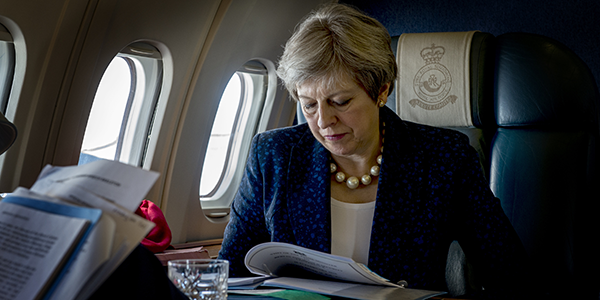The art of political survival: three lessons from Theresa May
Ben Worthy and Mark Bennister reflect on Theresa May’s short premiership and argue that, though her personal power did diminish after the 2017 general election, in this latter phase she retained more power of political office than often assumed.

Picture: By Jay Allen/Number 10 / (CC BY-NC-ND 2.0) licence
Leadership has become the focus of the world’s attention right now, and we instinctively look to the past, searching for lessons good and bad in former Prime Ministers and Presidents. FDR and Churchill spring to mind. But what of more recent leaders, like Theresa May? May appears to be only a lesson in poor leadership.
Whichever definition of leadership we take, it would seem she failed. If leadership is about manipulating situations so you can win, then May very clearly didn’t do that, losing an election and her major policy. If it is about ‘disappointing followers at a rate they can stand’ then she didn’t do that either – she disappointed everyone far too quickly and pleased no one. If being a leader is, according to perhaps the most famous definition by Neustadt, about the power to persuade, then May failed to persuade anyone. She failed to persuade the public to give her a majority, failed to persuade her MPs to support her Brexit policy, and then failed to persuade her party to keep her in place.
But digging deeper, Theresa May’s three-year premiership is more puzzling. Her time in office is divided into two very distinct phases, before and after the snap election of June 2017, when her dominance was transformed into defensiveness. Few leaders seem to have fallen so far and so fast. If May’s first year invited comparisons with Margaret Thatcher, her second led to commenters likening her with John Major, James Callaghan or, most damaging of all, Neville Chamberlain. This invites two questions, one obvious and one less so: why did it all go wrong and how, after 2017, did May then survive in office another two whole years?
One way of answering these puzzles are to track how a leader’s authority changes. Our Leadership Capital Index (LCI) measures authority, or leadership capital, in terms of a leader’s skills, relations and reputation. It tries to capture what Machiavelli said was the difference between the personality or character and the tides of fortune. Applying this to May tells us more about why May’s authority was lost but also about how she hung on so long. Tracing her leadership capital over time shows that May’s authority was certainly over-inflated in 2016–17 but underestimated 2017–19. May wasn’t as strong as she looked before June 2017 but not as weak as she appeared afterwards.
1. Beware of expectation inflation
Most Prime Ministers are over-valued, and mostly at the wrong time. Honeymoons fail to last and messy fallings out of love with the party and people can be brutal. Tony Blair complained that as Prime Minister you ‘begin at your most popular and least capable and end at your least popular and most capable’.
May certainly appeared capable in 2016. Taking over after the shock Brexit result, with the media and her party firmly behind her, she appeared to have political capital to spare. At this high point she declared, in a hubristic impulse that would create a neat petard to hoist her on later, ‘Brexit means Brexit’ and she added ‘we will make a success of it’. As the second British female Prime Minister, her pitch, like Thatcher’s, was as a woman and self-styled outsider. She was the ‘Vicar’s daughter’ taking on the ‘establishment’, encapsulated by her promise to ‘fight against burning injustice’ and govern ‘for the many’ (against, of course, the famous ‘liberal elite’ and ‘citizens of nowhere’).
This inflation helped drive a series of poor decisions, when May called for a hard Brexit in October 2016 at her party conference and triggered Article 50 in March 2017. These actions, intended to offer a radical solution and reassure Brexiteer MPs, proved divisive. They were also miscalculations, as they pushed Remain voters towards Labour, while failing to build the winning coalition of Leavers she sought. May gambled her leadership capital on a series of bets, none of which paid off. By the time May pushed her own Chequers agreement a year later, is was too late to salvage the authority to get, as it were, ‘Brexit done’.
2. Beware of weaknesses
Power, as Lyndon B. Johnson’s biographer Robert Caro famously pointed out, reveals. May’s declining leadership capital after June 2017 revealed her divided party and her poor political skills. Parties are the key to a leader’s strength or weakness: they can make or break a Prime Minister. May began with a majority of 17 but inherited an ‘increasingly over the shoulder politics’ of backbench rebellion, worsened by deep splits on Brexit. After 2017, Theresa May, like Callaghan and Major, became leaders struggling not to break their party, and seeking to persuade her own MPs to back her and not sack her. Like those leaders she became locked into a spiral of factional battles that further trained her authority. The press speculated almost daily on her demise.
Her party problems were then worsened by personal skills. As a number of people have pointed out, May’s path to power, like Gordon Brown’s, neatly side-stepped difficult leadership campaigns, so her electoral skills went ‘untested’ until the snap election campaign. She was pushed centre stage too late, and May’s style and communication were found to be lacking. From her U-turn on social care funding during the 2017 election campaign to poor media performances, when she floundered answering simple questions, like confessing that the naughtiest thing she had done was to run through wheat fields as a child, nothing went right. Even her life-long commitment to women’s equality was undermined with her pact with the DUP and her closeness to Trump.
Hidden amongst this was another weakness, not of May’s making: her gender. Women leaders are judged differently from male ones, held to different standards, and are more precarious than their male counterparts. The deep crisis of Brexit was caused, as Hozic and True remind us, ‘quite literally by men who happen to have gone to the same elite schools and have been competing with each other since adolescence’, who then promptly ran away when things got tough. Faced with a horrendously complex task, nevertheless, she persisted. Seen from the other side of Johnson’s double victory of general election and withdrawal from the EU her failure seems complete. Yet it was May’s deal, with the complex backstop cut out, and May’s election strategy, involving breaching the fragile/non-existent red wall, that won it. 2019 was as much May’s victory as Johnson’s.
3. Beware underestimation
After the snap 2017 election, May couldn’t do much that a Prime Minister should be able to do. She had no stable Commons majority, a leaky Cabinet, a polarised party and a pathologically disloyal Foreign Secretary. Few would imagine in June 2017 that May would still be in office almost two years later. May’s survival can be seen as more luck than skill, based on Corbyn’s failure to maintain a polling bounce post 2017 and the uncertainty of Brexit.
Nevertheless, May used what dwindling capital she had with care. She deployed what patronage, persuasion and political skills she could to stay in Downing Street. May, working ironically as a rhetorical premier, used a series of set-piece speeches to cajole, manoeuvre and persuade her party and the public. She had enough authority survive the resignation of both her Brexit Secretary and her Foreign Secretary and then later to fight off a vote of no confidence. Her party and even her own personal ratings held unexpectedly high, or at least didn’t stay as low as you would perhaps expect. Her government made itself a small target in Westminster, under-legislating and depriving the opposition of influence, while the DUP held firm.
Even Brexit, the issue that destroyed her premiership, protected her from removal and replacement, and at times let her portray herself as the embattled Prime Minister valiantly trying, so to speak, ‘to get Brexit done’. In a YouGov poll taken when she stepped down, 65% of respondents had ‘sympathy for a PM who was faced with what many see as an impossible task’.
May’s endurance reminds us of the power of just being there. Even a poorly positioned Prime Minister can do a great deal, and can survive because they are Prime Minister and no one else is.
This article represents the views of the authors and not those of Democratic Audit. It draws on their article: ‘“Dominance, defence and diminishing returns”? Theresa May’s leadership capital July 2016 to July 2018’ (2020), British Politics, which you can read here.
About the authors

Ben Worthy is Senior Lecturer in Politics at Birkbeck College, University of London. He is the author of The Politics of Freedom of Information: How and why governments pass laws that threaten their power.

Mark Bennister is Senior Lecturer in Politics at the University of Lincoln.





 Democratic Audit's core funding is provided by the Joseph Rowntree Charitable Trust. Additional funding is provided by the London School of Economics.
Democratic Audit's core funding is provided by the Joseph Rowntree Charitable Trust. Additional funding is provided by the London School of Economics.